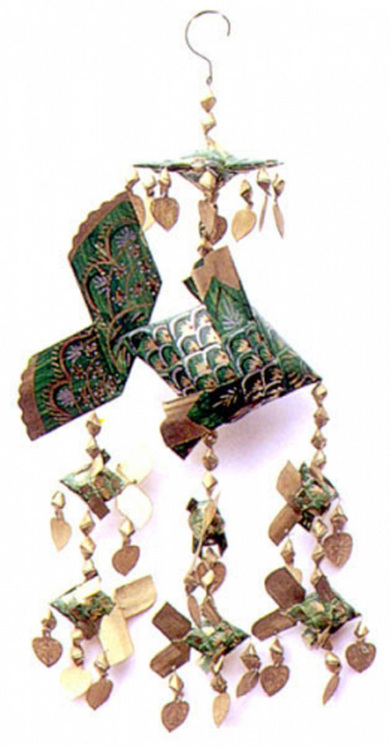Thai Palm Leaf Fish Mobile for the Cradle

Annotation
The fish mobile above is a type traditionally hung over the cradle in Thailand. It is made from the folded, woven leaves of the palm, especially in Phra Nakhon Si Ayutthaya province. The fish depicted is the Thai barb, or carp, which is a symbol of prosperity. The smaller fish, the offspring of the larger one, are thought to symbolize fertility. The custom of making the woven mobiles is indigenous to Thai Muslims, particularly the spice traders who sailed in houseboats along the Chao Phraya River. Fish mobiles are also placed in the entry of homes and shops as a harbinger of good fortune. The text describing the custom is from the 1948 book by Phya Anuman Rajadhon (1888-1969) Customs Connected with Birth and the Rearing of Children. The author is a prolific and well regarded literary figure and university professor. Although he did not receive formal academic training in anthropology, his writings have constituted a major source for anthropologists and others on customs from Siam, the traditional name for Thailand.
Text
"While the child is lying in the cradle, besides singing lullabys and swinging it to sleep, there is also a fish or waterskipper for the child to look at, hanging over the cradle toward the head, but not too high, for the child will roll its eyes upward to look at it. When a child rolls its eyes upward like this, they believe that this is a time when the purchasing mother [spirit] comes to molest it. These fish are tied and woven of nipa palm leaves in the form of a fish of fairly large size, and painted green, red, and, yellow. There are many small fish which are supposed to be its young, hanging from it. Even now these are sometimes seen for sale."1
1. Phya Anuman Rajadhon, Customs Connected with Birth and the Rearing of Children, 1948.
Credits
Text: Phya Anuman Rajadhon, Life and Ritual in Old Siam; Three Studies of Thai Life and Customs (New Haven: HRAF Press, 1961). Photograph: The Lima Place Ayutthaya (accessed July 5, 2010). Annotated by Susan Douglass.